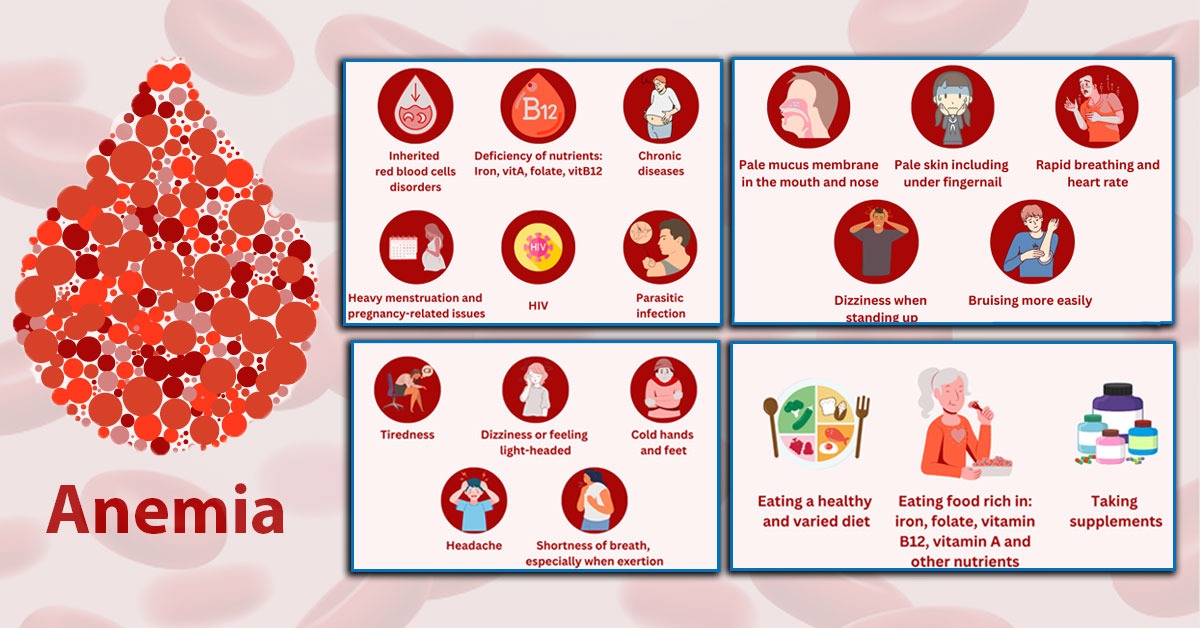Anemia is defined as a low number of red blood cells. In a routine blood test, anemia is reported as low hemoglobin or hematocrit levels.
Hemoglobin is the main protein in red blood cells that carries oxygen and delivers it throughout your body.
Red blood cells are disc-shaped blood cells that carry oxygen to the organs and tissues of your body. Anemia occurs when the number of healthy red blood cells in your body is too low.
Every part of your body needs a sufficient supply of oxygen to function effectively. Many symptoms of anemia, such as fatigue and shortness of breath, are caused by decreased oxygen delivery to your body’s vital organs and tissues.
If you have anemia, your hemoglobin level will also be low. If it is low enough, your tissues or organs may not receive enough oxygen.
Types
There are many forms of anemia, and each type has distinct symptoms. Some common types of anemia include:
- Iron deficiency anemia
- Aplastic anemia
- Vitamin B12 deficiency anemia
- Hemolytic anemia
Causes
- Genetic
- Bleeding
- Iron deficiency
- Blood loss
- Pregnancy
- Infection
- Chronic disease
- Autoimmune disease
- Dietary deficiency
- Low iron diet
- Certain medications
- Cancer
- Bone marrow disease
Risk Factors
- Family history
- Losing blood
- Menstruating
- Being pregnant and giving birth
- Having a chronic disease such as kidney disease, cancer, heart failure, or liver disease
- Being born prematurely
- Consuming a diet low in vitamins, minerals, and iron
- Taking medications that irritate the stomach, such as NSAIDs
- Intestinal disorders
Symptoms
Many symptoms of anemia are associated with a lack of oxygen being supplied to the body’s organs and tissues. If you have anemia, you may experience symptoms like:
- Headache
- Dizziness or lightheadedness
- A fast or irregular heartbeat
- Pain, including in your joints, abdomen, and chest
- Shortness of breath
- Pale or yellow skin
- Tiredness or weakness
- Problems with growth in children and teens
- Cold hands and feet
- Fainting
Other symptoms that may occur with some types of anemia include:
- Jaundice
- A heart murmur
- Enlarged lymph nodes
- Brittle nails
- An enlarged spleen or liver
- Trouble concentrating
- Inflammation of the tongue
Diagnosis
Laboratory tests are most often used to diagnose anemia. Some examples of tests that your doctor may order include:
- Hemoglobin levels
- CBC (Complete Blood Count)
- Serum iron levels
- Ferritin test
- Reticulocyte count
- Vitamin B12 test
- Folic acid test
- Fecal occult blood test
- Coombs test
- Bone marrow test
Treatment
Your treatment will depend on the type of anemia you have.
- Iron deficiency anemia: Iron supplements and dietary changes
- Vitamin deficiency anemia: Treatment can include dietary supplements and vitamin B12 injections.
- Anemia due to chronic disease: The doctor will focus on managing the underlying condition.
- Thalassemia: Treatment includes folic acid supplements, iron chelation, and for some people, blood transfusions and bone marrow transplants.
- Aplastic anemia: Treatment involves blood transfusions or bone marrow transplants.
- Hemolytic anemia: The treatment plan may include immunosuppressant drugs, treatment for infection, and plasmapheresis, which filters the blood.
- Sickle cell anemia: Doctors treat this with oxygen therapy, pain relief medication, and intravenous fluids. They may also prescribe antibiotics, blood transfusions, folic acid supplements, and cancer drugs.
Prevention
- Eating foods rich in iron, folate, vitamin B12, vitamin A, and other nutrients
- Exercising regularly
- Staying hydrated
- Protecting against infection
- Taking supplements: A doctor may recommend iron supplements like ferrous sulfate if you don’t get enough iron through your diet.
- Secondary prevention involves screening for, diagnosing, and treating iron deficiency.
Complications
- Depression
- Peripheral nerve damage
- Problems with memory
- Restless leg syndrome
- Confusion
- A weakened immune system
- Pregnancy complications, such as premature birth or low birth weight
- Developmental delay
- Heart problems, including:
- Heart attack
- Heart failure
- Angina
- Enlarged heart
- Arrhythmia
- Multi-organ failure, which can result in death

